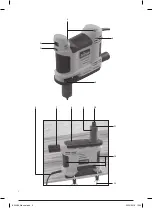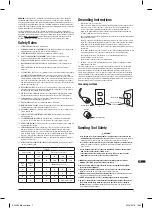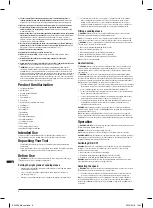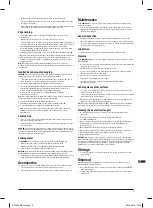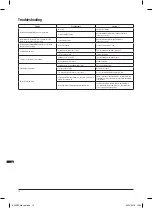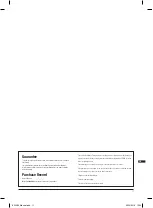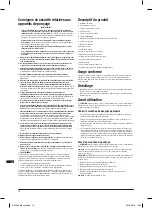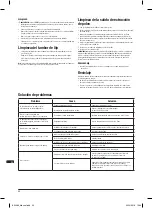
9
GB
• To adjust the speed, rotate the Speed Adjustment Dial to the desired setting
• The speed settings range from 1–6, with ‘1’ being the lowest speed setting and ‘6’ being
the highest speed setting
• If in doubt about choosing the correct speed setting suitable for the task, begin with a low
speed, examine the results, then adjust to a higher setting if necessary
Edge sanding
• The portable spindle sander is effective at sanding the edges of a variety of flat
workpieces (F)
• Always ensure the workpiece is secure and use clamps where necessary
• The Edge Guide (16) can be attached to the sander, if required (J). Apply the Edge Guide to
the sander and fix in the desired position with the Edge Guide Locking Screws (17) (Fig II)
1. Place the sander with the Sanding Base (8) flat on the workpiece and the Sanding
Sleeve (9) facing down, ensuring that there is more than enough room for the stroke length
of the oscillating spindle movement up and down
2. Switch ON the dust extraction system first (if connected) then switch the spindle sander ON
3. Make more shorter passes across the edge of the workpiece rather than longer, slower passes
4. Allow the sander to do the work and do not force the sander against the workpiece by
applying excessive pressure. Doing so could damage the workpiece and the tool or cause
an injury to the user
Note:
When using the Edge Guide, always start sanding from the corner or edge of a
workpiece. Start with the front feed guide against the workpiece and gradually feed the tool
onto the surface.
Inverted bench-mounted sanding
WARNING:
Always ensure the tool is switched OFF and the power plug is removed from the
mains power before bench mounting the spindle sander to a workbench.
• The portable spindle sander is effective at sanding the edges of a variety of workpieces
when the sander is securely inverted in the bench-mounted position (G)
1. Place the Bench Mounting Mat (14) near the edge of a stable workbench
2. Place the portable spindle sander in the inverted position on the mat and fix to the workbench
using the Bench Mounting Clamps (13), ensuring the spindle sander is secure on the
workbench by tightening the wingnuts on the Bench Mounting Clamps
3. Connect the dust extraction system hose to the Dust Extraction Port Adaptor
(if dust extraction is required)
Note:
It is recommended that a compatible dust extraction system always be used when the
portable spindle sander is in the inverted, bench-mounted position.
4. Select the desired speed on the Speed Adjustment Dial (1)
5. Switch ON the dust extraction system (if connected) then switch the sander ON
6. Use the Sanding Base (8) as a table top for stabilising the workpiece
7. Allow the sander to do the work and do not excessively force the workpiece against the
Sanding Sleeve (9). Doing so could damage the workpiece and the tool or cause an
injury to the user
Sanding tips
• If the tool is connected to a vacuum dust extraction system, switch the extraction device
‘ON’ before switching on the sander
• Clamp the workpieces to a workbench wherever possible. Ensure that workpieces cannot
move during work
WARNING:
Excessive pressure does not lead to a faster removal of material; however, it will
lead to premature wear of the Sanding Sleeve (9), and may cause damage to the tool. Sanding
performance and quality of finish are affected primarily by the choice of Sanding Sleeve (see
‘Selecting the right grade of sanding sleeve’).
Sanding metal
WARNING:
Some additional precautions have to be taken when sanding metal
• ALWAYS connect the sander via a suitable residual current device (RCD)
• ALWAYS connect the sander to a suitable workshop dust extraction system
• Clean the tool thoroughly before using it to sand metal
WARNING:
Hot metal particles and sparks could ignite residual wood dust. ALWAYS clean the
tool thoroughly when switching from sanding wood to sanding metal, and vice versa.
• A sanding sleeve that was previously used for sanding metal should not be used on wood
again. Residual metal particles may lead to scratches, and damage the workpiece
Accessories
• A range of accessories, including sanding sleeves of various grit, is available from your
Triton stockist. For your own safety, use only genuine Triton accessories.
• Spare parts can be purchased from your Triton dealer or online at toolsparesonline.com
Maintenance
WARNING:
Always disconnect the tool from the power supply before carrying out any
maintenance/cleaning.
• This tool is manufactured using class-leading components and makes use of the latest
in intelligent circuitry that protects the tool and its components. In normal use, it should
provide a long working life
General inspection
• Regularly check that all the fixing screws are tight. They may vibrate loose over time
• Inspect the supply cord of the tool, prior to each use, for damage or wear. Repairs should
be carried out by an authorised Triton service centre or technician. This advice also applies
to any extension cords used with this tool
Lubrication
• Lubricate all moving parts with a suitable lubricant spray at regular intervals
Cleaning
WARNING:
ALWAYS wear protective equipment including eye protection and gloves when
cleaning this tool.
• Keep your tool clean at all times. Dirt and dust will cause internal parts to wear quickly and
shorten the device’s service life
• Clean the body of your machine with a soft brush or dry cloth
• Never use caustic agents to clean plastic parts. If dry cleaning is not sufficient, a mild
detergent on a damp cloth is recommended
• Water must never come into contact with the tool
• Ensure the tool is thoroughly dry before using it
• If available, use clean, dry, compressed air to blow through the ventilation
holes (where applicable)
Sanding sleeve drum surfaces
• The surface of the Sanding Sleeve Drum (15) needs to be clean, free of dirt and foreign
matter, such as hair, fibres, sand, etc.
• In order to provide adequate adhesion for securing accessories, the surface of the Sanding
Sleeve Drum must be in good condition
• When used extensively, sanding sleeve drums will become worn, and the drum may not
provide the required diameter for adhesion anymore
Note:
This sander’s Sanding Sleeve Drums are NOT a warranty items. Replacement sanding
sleeve drums can be obtained as spare parts through an authorised Triton service centre.
Cleaning the dust extraction port
• Occasionally it may be necessary to unclog or clean the dust extraction port and
the channel
1. To clean the port and channel, first remove the Sanding Sleeve Drum (15)
(see ‘Fitting a sanding sleeve’)
2. Using a screwdriver (not supplied), remove the screws in the Sanding Base (8) and remove
the Sanding Base. Be careful not to lose the washers beneath the Sanding Base on
each screw hole (H)
3. On the Sanding Base, remove the metal plate to reveal the dust channel (I)
4. Clean the internal channel, dust port, and the belt cavity with a brush then compressed air
5. After thoroughly cleaning, replace the Sanding Base and tighten the screws
6. Replace the Sanding Sleeve Drum
WARNING:
After cleaning, ensure all washers, screws and bolts are in place and tightened
before reusing the sander. If the tool excessively vibrates or makes any strange noises different
to normal operation STOP using the tool and remove the plug from the power supply. Follow
the cleaning procedure again to ensure all parts are replaced correctly. If the sound and
vibration still occur, consult a qualified Triton service technician.
Storage
• Store this tool and its accessories after use in its case, in a dry, secure place out of the
reach of children
Disposal
Always adhere to national regulations when disposing of power tools that are no longer
functional and are not viable for repair.
• Do not dispose of power tools or other waste electrical and electronic equipment (WEEE)
with household waste
• Contact your local waste disposal authority for information on the correct way to dispose
of power tools
825289_Manual.indd 9
22/10/2018 12:54
Содержание TSPSP650
Страница 2: ...2 8 9 10 1 2 3 4 7 11 13 12 5 6 825289_Manual indd 2 22 10 2018 12 54...
Страница 3: ...3 5 14 13 16 17 15 18 7 825289_Manual indd 3 22 10 2018 12 54...
Страница 4: ...4 H C A B D E F G 825289_Manual indd 4 22 10 2018 12 54...
Страница 5: ...5 I J Fig I Fig II 16 17 5 5 825289_Manual indd 5 22 10 2018 12 54...


